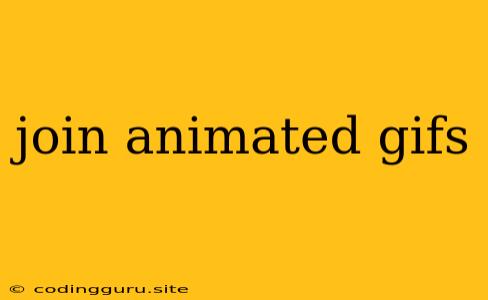Bringing Your GIFs to Life: A Guide to Joining Animated GIFs
In the digital age, GIFs have become a universal language. They convey emotions, reactions, and even complete stories in a way that static images simply can't. But what if you want to tell a story with multiple GIFs? This is where the ability to join animated GIFs comes in.
Why Join Animated GIFs?
Imagine wanting to create a dynamic reaction to a friend's funny meme. You could use one GIF, but why not chain together multiple GIFs for a more engaging and hilarious response? Or perhaps you're working on a visual project and need to seamlessly integrate several animations into a single GIF.
Joining GIFs can also enhance your storytelling capabilities. You can use it to:
- Create a narrative: Imagine a GIF sequence showing a character walking, encountering an obstacle, and finally overcoming it.
- Illustrate a process: Break down a complex process into smaller, digestible animated steps.
- Showcase a product in action: Show how a product works by combining multiple GIFs of its features.
Methods for Joining Animated GIFs:
While there are many online tools available, you can also utilize software that you may already have on your computer.
1. Using Online Tools:
- GIFs.com: This platform offers a simple interface for joining GIFs. Simply upload your GIFs, rearrange their order, and click "Join." You can also adjust the speed of each GIF within the sequence.
- ezgif.com: This site provides a wide range of GIF tools, including joining. You can upload multiple GIFs, adjust their frame rate, and even add text or stickers.
- Photoshop: Although primarily used for image editing, Photoshop can seamlessly join GIFs. You can import multiple GIFs into separate layers, adjust their timing, and then export the combined animation as a new GIF.
2. Using Software:
- GIMP: An open-source image editor, GIMP offers a wide range of image manipulation tools, including GIF animation. You can import individual frames from each GIF, arrange them in the desired order, and export the combined animation as a new GIF.
- ImageMagick: This powerful command-line tool is a must-have for anyone working with images, including GIFs. ImageMagick can be used to join GIFs using a simple command.
Tips for Joining Animated GIFs:
- Consider the frame rate: The frame rate of each individual GIF can affect the overall flow of the final animation. Try to use GIFs with similar frame rates for a smooth transition.
- Adjust the timing: Some GIFs may need to be sped up or slowed down to fit seamlessly within the sequence.
- Add transitions: Consider adding subtle transitions between GIFs, such as a fade-in or fade-out effect, to create a more polished look.
- Optimize for file size: If your GIF sequence is large, consider reducing the file size without sacrificing quality.
Examples of Joined Animated GIFs:
- A reaction GIF sequence that shows a character first surprised, then laughing, and finally doing a celebratory dance.
- A GIF showing the steps involved in baking a cake, starting with mixing ingredients and ending with the finished product.
- A GIF showing a product in action, showcasing its features and functionality.
Conclusion:
Joining animated GIFs is a fun and creative way to bring your ideas to life. Whether you're creating a reaction GIF, a visual project, or simply adding a touch of animation to your communication, the ability to join GIFs opens up a world of possibilities. By understanding the different methods available and following the tips outlined in this guide, you can easily join your GIFs and create stunning animations.
